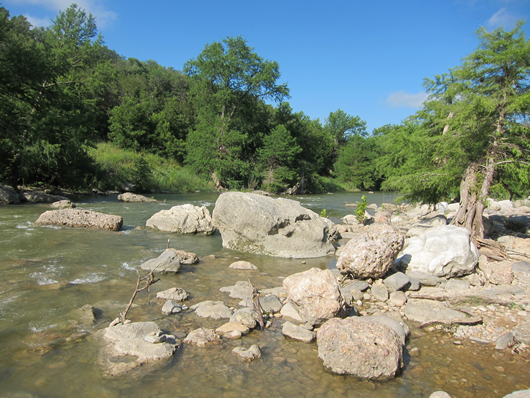Boulder Clusters
What is it?
Boulder clusters are large rock placed in the stream individually or in groups to protect eroding banks and provide instream cover for fish and invertebrates.

Conservation Benefits
- Provides instream habitat and current velocity refuges for fish and other aquatic organisms
- Reduces stream bank erosion
What does it include?
Boulders should be harvested from the surrounding watershed or if boulders are not available, imported boulders should mimic native materials. Boulder size can very depending on if it will be used for instream habitat or to protect eroding stream banks. Technical experts should be consulted to determine size, number, and placement of boulders in the stream. Smaller boulders may need to be replaced after large flood events.
Boulder Cluster Links
- Boulder clusters (NRCS)
- Boulder clusters (p 155; Center for Watershed Protection)
- Boulder clusters (US Army Corp of Engineers)
- Boulders (p 304; Cooperative Research Centre for Catchment Hydology)
- Full-width structures: rock-boulder structures (p268; Cooperative Research Centre for Catchment Hydrology)
Boulder Clusters Bibliography
- Roghair et al. 2002. Response of a brook trout population and instream habitat to a catastrophic flood and debris flow. Transactions of the American Fisheries Society 131: 718-730.
- Schmetterling and Pierce. 1999. Success of instream habitat structures after a 50-year flood in Gold Creek, Montana. Restoration Ecology 7: 369-375.
- Talmage et al. 2002. Relation of instream habitat and physical conditions to fish communities of agricultural streams in the northern midwest. North American Journal of Fisheries Managment 22: 825-833.
- Thompson. 2002. Long-term effect of instream habitat-improvement structures on channel morphology alon the Blackledge and Salmon Rivers, Connecticut, USA. Environmental Management 29: 250-265.
- van Zyll de Jong et al. 1997. An evaluation of instream habitat restoration techniques on salmonid populations in a Newfoundland stream. Regulated Rivers: Research & Management 13: 603-614.